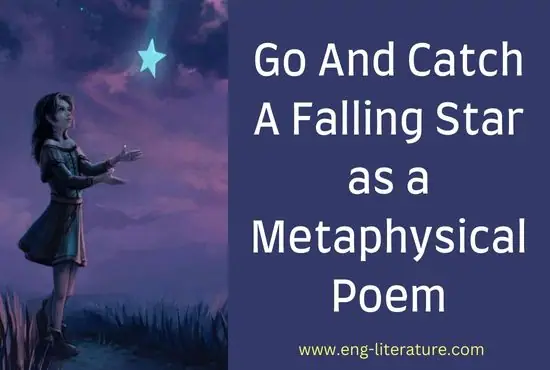Go And Catch A Falling Star as a Metaphysical Poem
The song Go And Catch A Falling Star is a song, peculiar to Donne, and different from typical Elizabethan songs. It is concerned with women, but not a poem on womanly love or love for women. In fact, the song is distinctly different from Donne’s usual love-poetry.
The song is actually on feminine inconstancy. Its theme is the lack of fidelity in women. The poet’s point of contention is that no woman who is both true and fair, can be traced anywhere. This is well struck in the last two lines of the second stanza
“No where
Lives a woman, true and faire.”
But this is not all. The poet even claims that constancy in women is not merely rare, but also short-lasting. Even if a woman be found fair and true, she will change and prove false in no time-
“Yet shee
Will bee
False, ere I come. to two or three”
This is, however, no characteristic attitude from Donne. His tone here is playful, rather witty, although it may smack of some sarcasm. In fact, the song represents the metaphysical way to mingle the serious with the light. The subject-matter is, no doubt, grave-the inconstancy of women. No fair woman can be fair in attachment and devotion. This forms, too, the very serious charge from Hamlet in Shakespeare’s great play, after the same name:
“Frailty, thy name is woman.”
But Shakespeare’s Hamlet has a serious tone, while Donne’s all light and witty. His wit flashes here and there, as he goes to emphasize feminine frailty. The concept of getting a child from the root of a mandrake, the Devil’s cleft foot, the visualization of invisible materials are all witty enough.
Also Read:
- The Anniversary by John Donne Analysis
- The Canonization by John Donne Critical Analysis
- The Sun Rising by John Donne Analysis
- John Donne’s The Sunne Rising Line by Line Analysis
- The Anniversary Summary, Theme, Line by Line Analysis
- The Good Morrow Summary, Theme, Line by Line Analysis
- The Good Morrow Analysis
- A Valediction: Forbidding Mourning Analysis
Again, the poet’s mention of a pilgrimage to see a fair and faithful woman has a slightly sarcastic touch. Even his conclusion that she will be false, ere the poet comes, to two or three, has a satiric stroke. But in all these cases, the poet bears out a lively mood of fun and mockery to make his song enough diverting, rather than coldly didactic.
All this marks the intellectualism of metaphysical poetry. The meta- physical style is more intellectual, less emotional, and that is well borne out in Donne’s song. Metaphysical intellectualism turns poetic impulsiveness into prosaic logicality. By means of arguments and analogies, no doubt framed wittily enough, he reaches his central assertion that fair and faithful women are rare. Indeed, a chain of diverting points of logic sums up the central theme and arrives at the concluding observation in the typical metaphysical manner.
The metaphysical poetic style exhibits precision. It does not indulge in elaboration but rather concentrates on conciseness. The rarity of a woman, faithful and fair, or her quickly changing fidelity is precisely but distinctly stated. Therein is found the innate quality of Donne’s song as a piece of metaphysical artistry.
Again, the metaphysical imagery, drawn quite precisely, from a wide field of mythology, Christianity and legends, is more prosaic and commonplace than emotional and elegant. Donne’s song has some rare but very precise images, such as ‘mandrake’s roote’, the Devil’s cleft foot, the mermaid’s music, and so on. The metaphorical analogy of ‘snow white haires’ is well conceived. Of course, such images are very few in number.
The song also represents the metaphysical mood that combines, as noted already, the serious and the light. It reveals definitely a skeptical and cynical frame of mind that taunts and debunks the nature of a fair woman. The poet mocks at the inconstancy and fickle-mindedness of such a woman. But his mood is lightened with a jesting, fun-making approach, that both laughs and lashes.
The song is written in a regular stanza pattern. There are three stanzas, of nine lines each. The rhyme-scheme is exactly of a melodious song, with the first four lines, rhyming alternately, while the fifth line and the sixth and the last three lines separately rhyme together.

Hello, Viewers! Besides being the Founder and Owner of this website, I am a Government Officer. As a hardcore literary lover, I am pursuing my dream by writing notes and articles related to Literature. Drop me a line anytime, whether it’s about any queries or demands or just to share your well-being. I’d love to hear from you. Thanks for stopping by!
